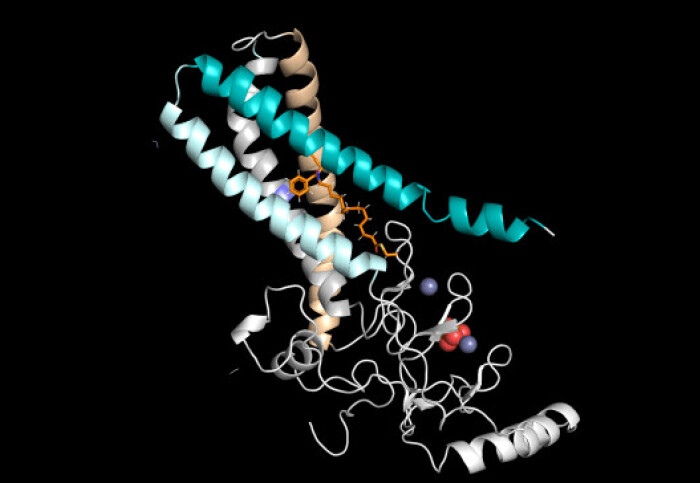New class of cancer and immunology drug targets mapped with new tagging system

A modified ZDHHC enzyme and lipid. Credit: Jana Volaric
Researchers have used ‘click chemistry’ to map the role of a group of enzymes that could be key for developing new medicines in cancer and immunology.
The team, from Imperial College London and the Francis Crick Institute, published their findings in Nature Biotechnology.
This new approach building on Nobel Prize-winning technology will be fundamental for furthering drug development. Professor Ed Tate
Many proteins known to be linked to disease can’t be targeted directly as they are too floppy or too smooth to provide a foothold for a drug to bind. Instead, researchers need to target them indirectly via processes that modify them.
A type of modification called palmitoylation involves attaching a fat molecule (known as a lipid), so the protein can bind to the fatty membranes which envelop the contents of the cell, allowing it to take on a particular function.
Enzymes called ZDHHCs are responsible for directing palmitoylation to specific proteins, so offer a new way to target proteins indirectly in diseases. However, humans have 23 different ZDHHCs, and understanding which proteins each one modifies, and therefore also which might be best targeted in disease, has been very challenging.
Bump and hole
The team used a method called ‘bump and hole’, which involves putting a ‘hole’ into a ZDHHC enzyme and a ‘bump’ into the lipid, so that they fit together. They then combined this technology with click chemistry so that any protein receiving the ‘bumped’ lipid from this ZDHHC will be tagged.
This method allows identification of the specific proteins one ZDHHC modifies for the first time. Proteins which are related to disease can, in future, be targeted indirectly by inhibiting the associated ZDHHC.
To progress the research into drug discovery, the researchers have also screened a very large library of compounds to find effective ZDHHC inhibitors.

Professor Ed Tate, Group Leader of the Chemical Biology and Therapeutic Discovery Satellite Laboratory at the Crick and the GSK Chair in Chemical Biology at Imperial College London, said: “Using this precise tagging system to identify which enzymes target specific proteins will allow us to understand what happens if we block these enzymes.
“This new approach building on Nobel Prize-winning technology will be fundamental for furthering drug development, allowing us to develop medicines which indirectly target currently ‘undruggable’ proteins. It could be used to find new drugs for cancer and immune disorders, but also to fight infectious diseases like malaria. We’re just at the beginning of this exciting journey, but we expect that drugs developed based on this method could be in clinical trials within five years.”
Truly a game changer
Dr Tony Ocasio, former Senior Laboratory Research Scientist at the Crick, and now Senior Screening Platform Scientist at Econic Biosciences, said: “This multi-collaborative and interdisciplinary project marries two disparate fields within the chemical and biological sciences, highlighting what we can achieve when scientists work together. Being able to apply a bump-hole strategy to the ZDHHCs and pairing this with chemical proteomics is truly a game changer.
"My hope is that this technology reinvigorates the lipid biology field by providing tools to link specific substrate palmitoylation to disease, and creating drug discovery programmes aimed at developing therapies around management of these ZDHHC targets.”
Paul Mercer, Head of Collaboration at the Crick, said: "This ground-breaking work exemplifies the Crick’s vison of making discoveries without boundaries, adding a powerful new layer to the unique suite of ZDHHC technologies developed by Ed Tate’s group at the Crick and Imperial College London. The platform unlocks the exciting prospect of developing novel drugs against an entirely new target class, with potential in a range of high-value disease areas which the team are actively pursuing."
Funded by Cancer Research UK, this was a coordinated effort across multiple teams at the Crick and Imperial College London. Ed and first author Tony Ocasio worked with Julian Downward, group leader of the Oncogene Biology Laboratory; James Macrae, head of the Metabolomics facility; and the Chemical Biology team.
-
Based on a press release by The Francis Crick Institute.
Reference: Ocasio, C. et al. (2024). A palmitoyl transferase chemical-genetic system to map ZDHHC-specific S-acylation. Nature Biotechnology. 10.1038/s41587-023-02030-0.
An earlier version of this article was first reported on bioRxiv.
Article supporters
Article text (excluding photos or graphics) © Imperial College London.
Photos and graphics subject to third party copyright used with permission or © Imperial College London.
Reporter
Hayley Dunning
Communications Division